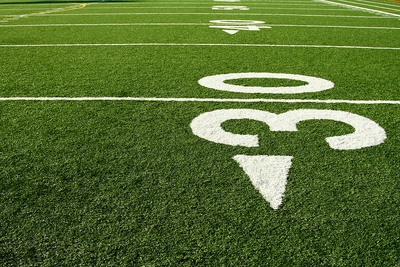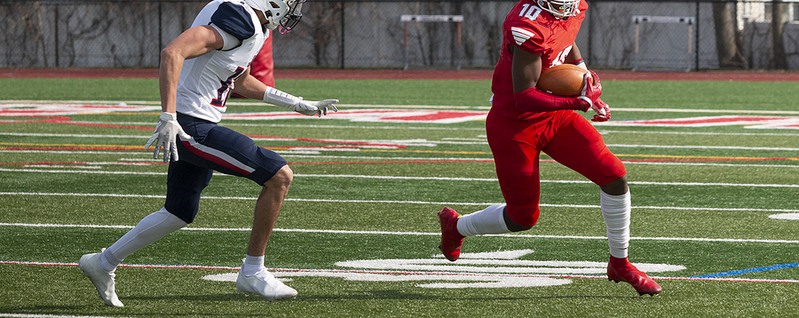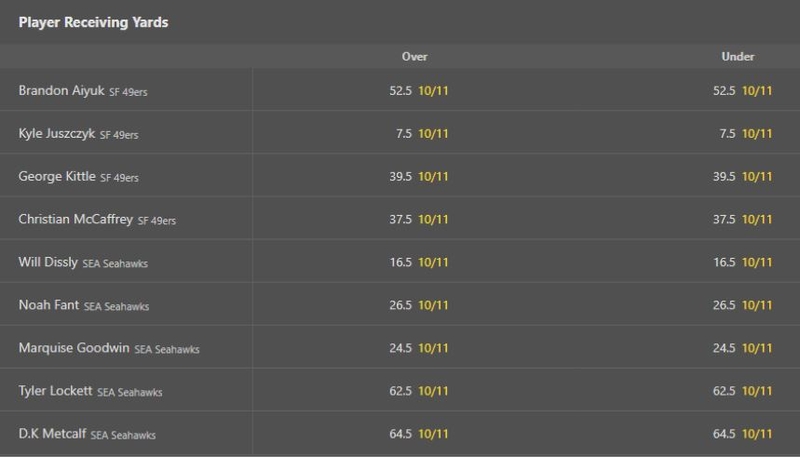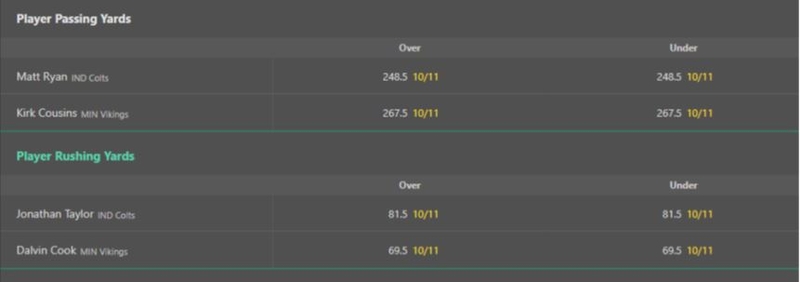 In American Football, like with many ball sports, teams will generally try and progress the ball up the pitch while retaining possession of it.
In American Football, like with many ball sports, teams will generally try and progress the ball up the pitch while retaining possession of it.
There are two main ways of doing this, one being running with the ball, known as rushing, and the other being catching a thrown ball, with the two sometimes combined during one play. Being able to advance with the ball successfully, whether as a runner, catcher or thrower, is therefore a very useful skill and one that ultimately wins football games.
Although it is a team sport, individual statistics are very much a big thing in a lot of American sports and football, as they call it, is no exception. Talk of rushing yards, passing yards and receiving yards are very much a standard part of the game’s vocabulary. Due to how much interest there is in these player-specific metrics, many bookies now allow you to bet on them.
So, if you ever find yourself in the mood for some individual player bets, one of the three options we are about to discuss may well be worth your consideration.
What Do Rushing Yards/Passing Yards/Receiving Yards Mean?

Before we take a closer look at the betting markets, it is worth covering the basics of what these terms mean, especially as they are very American-football specific. The three are grouped together because they are all measures of how far a player has managed to progress the ball, quite literally in yards. They differ, however, because they each look at a different way of getting the ball forward.
- Rushing Yards – How far a player has run with the ball.
- Passing Yards – How far the quarterback (usually) has passed the ball forwards. For this to count the pass must be successfully caught by a teammate within bounds. If the player is able to run with the ball after catching, these yards are also included. This is known as yards after catch (YAC)
- Receiving Yards – Basically the same as passing yards but credited to the catcher, the receiver, of the ball, rather than passer.
It is worth stressing that only the vertical progress is taken into consideration when totting up these yards. If a running back zig-zags across the pitch before being tackled, but only actually makes five yards of progress up the pitch, then that is five rushing yards. Similarly, if a quarterback throws the ball completely sideways, and the receiver is instantly tackled, then they would not gain any passing yards.
Due to this it is possible for negative yards to be accumulated should a player be responsible for losing ground. If a running back is handed the ball and then is immediately tackled, they will end up losing a few yards because the ball has been passed backwards to them. In the NFL, a quarterback will not, however, get negative rushing yards whenever they are sacked but they will do in college football. In both forms of the game though, a kneel down will go down as negative rushing yards against a quarterback.
Receivers are also not immune to negative yards. If they receive the ball behind the line of scrimmage and are unable to progress further when being tackled, this would go down as a negative for them. So, now and again, some players whether it be a quarterback, running back, wide receiver or whoever, may end a game on negatives yards, or even the entire season in some very extreme cases. Back in the 2016 campaign, Reggie Bush became the first running back in NFL history with at least 10 carries to finish with negative yards. Unsurprisingly, he announced his retirement not too long afterwards.
Examples
- Rushing Yards – A running back is handed the ball and then progresses 15 yards ahead of the scrimmage line before being forced out of bounds. They would gain 15 rushing yards for this.
- Passing Yards – A quarterback launches a huge 60-yard throw from five yards behind the scrimmage line which is caught by the wide receiver, who is then tackled. The quarter-back would gain 55 yards passing yards for this effort (60-5) and the wide receiver the same (in receiving yards).
- Receiving Yards – A wide receiver catches a ball 20 yards from the scrimmage line following a throw and is able to run another 10 before being tackled. For his efforts he is credited with 30 receiving yards (and the QB 30 passing yards).
In all instances it does not matter if possession is overturned following the play whether it be by turnover on downs or a fumble. The ball has still progressed x number of yards so a player still receives credit for that.
Rushing/Passing/Receiving Yards Betting

No matter if you want to bet on rushes, passing, or receiving, the type of bets available are usually the same. To access them, you will likely need to head to the ‘player props’ or ‘player’ section of an NFL match due to start reasonably soon. If this is not visible, you may be looking at a match too far in the future.
Within this section, depending on how big your chosen bookie is on NFL, you may find some, or all of the below betting options. The list of available players for each one will depend on whether you are looking at rushing, passing or receiving yards.
For receiving yards, this typically features the longest list as there are many players that will gain a decent amount of receiving yards during a game, not just the starting wide receivers. Tight ends, fullbacks and running backs for example may also be included in the betting list. Typically, bookmakers will pick from among the highest scoring players from each team.
With passing yards and rushing yards though, you are likely to find just a couple of options. As standard you will have the two starting quarterbacks available for the former and two starting running backs for the latter. It is possible that these players will be substituted during the game and someone else accumulates yards, but bookmakers will often not give prices for these. Even though it is possible for anyone on the team to gain rushing yards, bookies tend to focus on the one or two biggest points scorers for each team.
Over/Under Bets
For this particular betting market, you simply have a choice of two options to make. Will the specified player achieve fewer than the yards total stated or will they achieve more. Typically, what a bookmaker will do here is adjust the values to create two evenly priced bets, giving you something of a 50/50 choice with odds both options priced slightly lower than evens.

Here, for example, D.K Metcalf is expected to collect more receiving yards than anyone else on the field, hence why his base figure is 64.5. You have probably also spotted here that all figures provided end with .5, rather than being whole numbers. This ensures there will always be a winning and losing bet because yardage progression is always rounded to the nearest yard. Therefore, Brandon Aiyuk, for example, could end up with 52 received yards (under), or 53 receiving yards (over) but not 52.5, so the bet cannot result in a push (a tie, where the bet is void).
It is possible that a bookmaker may offer a whole figure as the over/under threshold. Should a player end the game with exactly this number, only then will the bet end in the push (stake returned, no money won or lost).

The same over/under principle applies for passing and rushing yards in this Colts vs. Vikings clash. If you bet on Matt Ryan to get over 248.5 yards, he would need to register 249 or more just by throwing the ball. Similarly, if you bet on Dalvin Cook to get under 69.5 rushing yards, they would need to register no more than 69. Should he end up with 0 yards on account of not playing any part of the match due to injury, this bet is void and your stake would be returned. Most bookies will also do this if your chosen player is fit to play but takes no part in the game due to a tactical decision.
Yards Milestones
Rather than going for an under/over bet, one other market you might find is known as milestone bets. Here you are simply betting on a selected player meeting or exceeding the stated number of yards. If you were to bet on 300 yards for Kirk Cousins here, the Viking quarterback would need to rack up a minimum of 300 yards for your bet to be a winning one. Unlike with over/under bets, you are always betting on a player to meet or exceed the milestone, you do not have the option to go under.

For a receiver or runner these milestones are usually based on 100 yards, with alternative markets offering longer odds (for more yardage) or shorter odds (fewer yards gained).
Combined Markets
To focus more on an all-round performance, you may want to consider dipping into one of the combined markets.
There are two different combinations available, you can either have:
- Rushing & receiving yards
- Passing and rushing yards
There is never the option of passing and receiving yards being combined as this would require a quarterback to throw the ball forwards, and catch it themselves. Technically a quarterback can do this, as Marcus Mariota found out when catching his own blocked pass for a touchdown in 2018, but it is so rare it is not worth making a betting market for.

In the example above, it is simply that Geno Smith’s passing and rushing yards will be totalled together to give him one combined score.
If you bet over 264.5 and he ended the game with 250 passing yards and 20 rushing yards, you would be a winner as his total is 270.
Similarly, in the example below, if you backed McCaffrey for over 118.5, 60 rushing yards and 59 receiving yards would be just enough (60 + 59 = 119).

Alternative Lines
The concept of alternative lines is common in US sports betting where many wagers are generally created to give two options, both priced at around evens. Check out our separate feature on points betting for information on how that applies there but as we have seen with the overs/unders in terms of passing and so on, the yards are usually set at a figure which gives both overs and unders a broadly similar chance of occurring.
As touched on above with milestones, however, bookies may also give extra options for those who want either longer odds, or a safer bet (with shorter odds). So if a bookie believes, as per our first screenshot above, that a player is likely to receive for around 52 or 53 yards, the main, or standard, line is set at 52.5 with both options priced at, in this case, 10/11.
However, the bookmaker may also offer the same player with an over/under line set at 56.5 points. In this case, opting for overs will pay out at more rewarding odds, whilst unders will be a less risky proposition but with a shorter price. The best American football betting sites around will offer a number of alternate lines, catering to fans who believe the player might have a really good game, or a particularly poor one, and want to bet accordingly.
Other Rushing, Passing and Receiving Bets
If this is an area of betting that really interests you, then be sure to check out what different bookies have to offer as you might find an array of further markets available.
One option might be a match bet, or head-to-head, where you are wagering on which player will pass, receive, or run for the most yards. Such players might be on the same or opposing teams.
Another market might consider who will be the first player to reach a certain yardage milestone; for example the first quarterback to pass for 100 yards in the game.
Bookies often create new markets too so be sure to have a good look round and see what other stats-based bets you can uncover.
